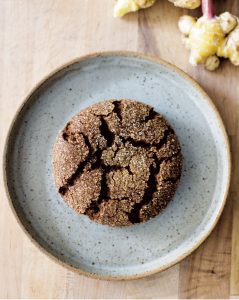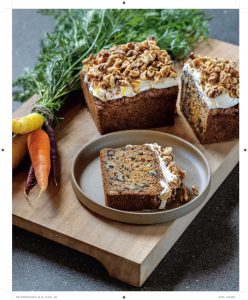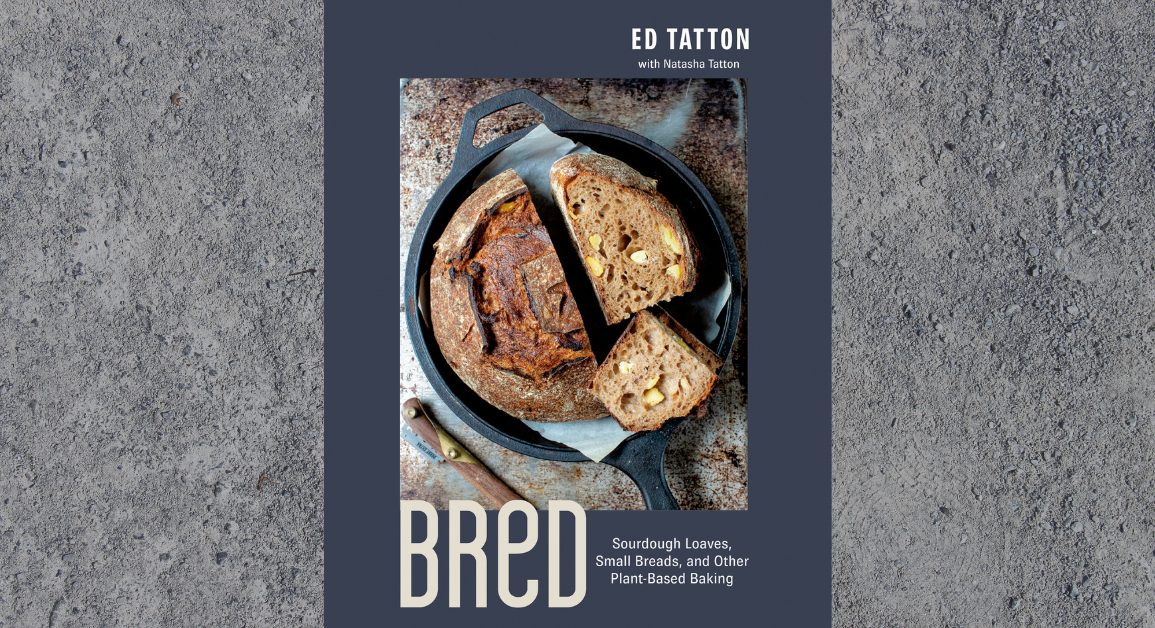BReD: The Cookbook – Happy New Year. I always feel that January is a month to ‘hunker down’ and tidy up the house and prepare for sunnier days. It’s also good to stay inside and bake and, of course, it’s Veganuary for some, so I thought I’d tell you about a cookbook that was launched recently: BReD.

Sourdough bread is naturally vegan – flour, water, and salt transformed into extraordinary, delicious bread. Ed Tatton, vegan chef, artisan bread-maker, and co-owner of Canadian vegan cafe and bakery BReD, has been refining recipes and techniques for naturally leavened sourdough for years. These include a wide array of boules, baguettes, loaves, flatbreads, buns, and pizza. He uses plant-based alternatives in some savoury and sweet sourdoughs that would traditionally include dairy (butter, milk, or buttermilk) including panettone buns, hot cross buns, sticky buns, cinnamon buns, English muffins, brioche, and babka. BReD is a plant-based book for serious vegan bakers that goes beyond just making bread. You can take baking to the next level with gorgeous vegan baked goods – from cakes, muffins, and scones to biscuits, cookies, and tarts. The book also includes gluten-free recipes (bread and other baked goods), discard starter recipes to further zero-waste efforts, and an offering of dips, spreads, and accompaniments to complement the bread. Penguin Random House publishes it at £34 rrp. Here is a couple of recipes from the book:
Ginger and Molasses Cookies. Makes 14 cookies.

Warming, sweet, crunchy, chewy, and moreish, these cookies are a favourite of ours when the weather starts to turn in the autumn. I think it’s the delicious complex flavour that comes from the molasses—a syrup derived from brown sugar that is used in making rum.
As soon as I tasted Seed to Culture’s locally grown organic ginger, I wanted to use it in my bakes. I thought a ginger cookie was the best way to celebrate this amazing plant. You can use store-bought ground ginger, but you really must try making your own. It’s a revelation! The flavour is floral and familiar but has so many levels. See the Note for how to dehydrate fresh ginger and blend it into a powder.
note: To make your own ground ginger, set a dehydrator to 140°F (60°C). If your fresh ginger has thin skin, there is no need to peel it, but if the skin is thick, then peel it first. Finely chop the ginger, or grate on the large holes of a box grater. Spread the grated ginger on a dehydrator tray lined with parchment paper or a silicone baking mat. Dehydrate for 24 hours, until the
ginger is completely dry. Alternatively, place the grated ginger on a baking sheet and dehydrate in the oven on the lowest setting possible for 1 to 2 hours, until completely dry. Blend the dehydrated ginger on high speed in a spice grinder or liquidizer to a fine powder. Store the ground ginger in an airtight container in the freezer for up to 3 months to keep it fresh. Use in any recipes where ground ginger is called for.
340g (1½ cups + 1 tablespoon) cold vegan butter 250g (1¼ cups loosely packed) brown sugar 150g (½ cup) blackstrap molasses
125g (½ cup) pure maple syrup
20g (1½ tablespoons) pure vanilla extract 585g (4¼ cups) all-purpose flour
20g (1 tablespoon) baking soda
25g (5 tablespoons) ground ginger (or 100g/3.5 oz/1 cup dehydrated ginger, ground)
15g (2 tablespoons) ground cinnamon
7g (3 teaspoons) ground nutmeg 5g (1 teaspoon) fine sea salt
100g (½ cup) raw cane sugar, for rolling
Method
In the bowl of a stand mixer fitted with the paddle, cream together the butter and brown sugar on medium speed until smooth, 2 to 3 minutes.
Add the molasses, maple syrup, and vanilla and beat on medium-low speed until fully combined. Stop the mixer and scrape down the sides and bottom of the bowl with a rubber spatula as needed to ensure thorough mixing.
In a large bowl, sift together the flour, baking soda, ginger, cinnamon, nutmeg, and salt. Whisk to combine.
Add half of the dry ingredients to the wet ingredients and mix on low speed to combine. Add the remaining dry ingredients and mix on low speed until fully incorporated, 1 to 2 minutes. Stop the mixer and scrape down the bottom and sides of the bowl with a rubber spatula as needed to fully mix all the ingredients. Cover the bowl and chill in the fridge for 1 hour. This will firm up the dough and make weighing and shaping easier and less messy.
Line 2 large baking sheets with parchment paper or silicone baking mats. Have a small bowl of water ready. Divide the dough evenly into 14 balls (about 110g/3.9 oz each). Roll each ball in your palms to achieve a smooth finish, using a little water on your hands to prevent sticking. Slightly flatten the balls into discs about 1 inch (2.5cm) thick.
Arrange the cookies on the lined baking sheets and chill them in the fridge for at least 1 hour but ideally overnight. (Unbaked cookies can be stored in an airtight container in the fridge for up to 3 days before baking or in the freezer for up to 1 month. If frozen, defrost the cookies in the fridge for 8 to 10 hours or overnight before baking.)
When ready to bake, arrange the oven racks in the upper and lower thirds of the oven and preheat to 340°F (170°C).
Place the cane sugar in a medium bowl and roll the cookies in the sugar. Return the coated cookies to the baking sheet, leaving 2 inches (5cm) between them to allow for spreading. Bake the cookies until they are cracking and dark brown on top, 14 to 16 minutes. If you are not using a convection oven, you may need to rotate the cookies halfway through. Allow the cookies to cool completely on the baking sheets.
These cookies are best enjoyed on the day of baking but can be stored in an airtight container in a cool, dry place for up to 3 days.
Spiced Carrot and Walnut Cake
 Makes one 9 × 5 × 3-inch (23 × 12 × 8cm) cake, serves 7 to 8
Makes one 9 × 5 × 3-inch (23 × 12 × 8cm) cake, serves 7 to 8
Carrot cake is so ancient that historians do not quite agree on exactly where it came from, but it has enjoyed immense popularity since the Second World War in Britain, a time when carrots were used to add sweetness to cakes when sugar was being rationed.
This cake is so good that our best friends in Scotland chose it to be their wedding cake. For a delicious celebration cake, it can easily be doubled and baked in two or three 9-inch (23cm) springform pans, then layered with Cream Cheeze Frosting. It is easier to make a big batch of frosting in a stand mixer, but if you only have a hand-held electric mixer, you can halve the recipe below. Leftover icing can be stored in an airtight container in the fridge for up to 2 weeks or in the freezer for up to 1 month. The frosting should be thawed in the fridge overnight before using.
note: Toasting the walnuts first adds a deep flavour throughout the cake. We use beautiful local carrots from Helmer’s Organic Farm in Pemberton, as their sweet and fruity flavour is incredible. I highly recommend making this cake when you can find local carrots, as it will take your cake to the next level.
Have you noticed your walnuts turning a little black inside the baked cake? Try lightly coating them in a small amount of flour, then shaking in a strainer to remove the excess flour before mixing through the batter. The vinegar and baking soda can cause a reaction that discolours the nuts. The flour acts as a barrier to prevent blackening.
Cream Cheeze Frosting (makes enough for 2 cakes)
75g (¼ cup) cold vegan butter 125g (¾ cup) vegan icing sugar 125g (½ cup) vegan cream cheese
Sponge
250g (2½ cups) chopped walnuts.
35g (3½ tablespoons) ground flaxseed
310g (1¼ cups + 1 tablespoon) unsweetened oat milk 100g (¼ cup + 3 tablespoons) organic canola oil 135g (2/3 cup) fine raw cane sugar
10g (2 teaspoons) pure vanilla extract 10g (2 teaspoons) apple cider vinegar 165g (11/3 cups) all-purpose flour
75g (½ cup) whole wheat flour
7g (1½ teaspoons) baking powder 7g (1 teaspoon) baking soda
3g (a pinch) fine sea salt
5g (1 teaspoon) ground cinnamon 5g (1 teaspoon) ground ginger
3g (a pinch) ground nutmeg
250g (2¾ cups) grated unpeeled carrots (grated on the large holes of a box grater)
Topping
Zest of 1 lemon (using a microplane)
Make the cream cheeze frosting.
In the bowl of a stand mixer fitted with the paddle, beat the butter on medium-high speed until soft, 1 to 2 minutes. Add the icing sugar and continue beating on medium-high speed until smooth, 2 to 3 minutes.
Add the cream cheese and beat on medium-high speed, gradually increasing the speed to high until smooth, 2 to 3 minutes. Scrape the frosting into an airtight container and chill in the fridge for 2 to 3 hours.
Make the sponge and bake.
Preheat the oven to 350°F (175°C). Lightly coat a
9 × 5 × 3-inch (23 × 12 × 8cm) loaf pan with a neutral vegetable or sunflower oil spray and line the bottom and sides with parchment paper.
Spread the walnuts on a small baking sheet and lightly toast in the oven until golden brown, 5 to 6 minutes. Let cool.
To make your flax egg, whisk together the flaxseed and oat milk in the bowl of a stand mixer until a smooth paste forms. If there are any lumps, push a small rubber spatula against the side of the bowl to break them up. Let sit for 10 minutes to bloom and thicken.
To the flax egg, add the canola oil, cane sugar, vanilla, and apple cider vinegar. Mix on medium speed with the paddle for 1 to 2 minutes to combine.
In a large bowl, whisk together the all-purpose flour, whole wheat flour, baking powder, baking soda, salt, cinnamon, ginger, and nutmeg.
Add the dry ingredients to the wet ingredients and mix on medium-low speed until just incorporated 1 to 2 minutes.
Add the grated carrots and 150g (1½ cups) of the toasted walnuts (reserve the remaining walnuts for decorating). Lightly mix on low speed for 1 minute. Remove the bowl from the mixer. Using a rubber spatula, stir the batter from the bottom to check that everything is fully mixed together.
Scrape the batter into the prepared loaf pan and smooth the top with a rubber spatula. Bake until a skewer inserted into the centre of the cake comes out clean, 60 to 70 minutes. Let the cake cool in the pan for 15 to 20 minutes. Turn it out onto a cooling rack, turn right side up, and let cool completely, at least 60 minutes, before frosting.
Frost the cake
Spoon on the chilled frosting and use a small offset spatula to spread it over the top of the cake, gently swirling and decorating with as much of the frosting as you like. Sprinkle the lemon zest over the cake and finish with a generous scattering of the reserved toasted walnuts.
As this cake is oil-based, it’s very moist and can be stored in an airtight container in the fridge for up to 5 days.
The Seasoned Gastronome


